MARK BANDO'S WEBSITE
Holland Situation map, 18 September, 1944
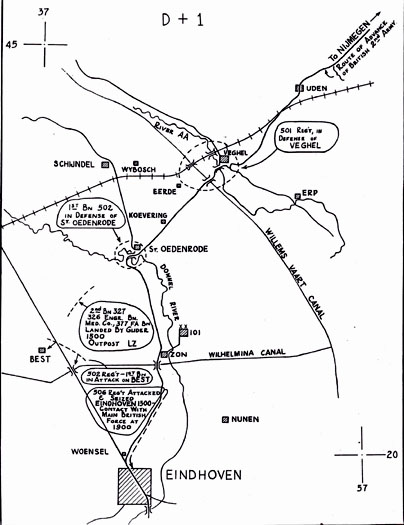
In Deadly Combat Near Best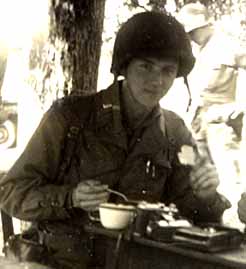 As IPW officer (prisoner of war interrogator) for the 502 regiment, Captain Joe Pangerl headed the IPW Team #1.
The photo above shows Joe eating lunch at Dodewaard, Holland in October of 1944.
Sometimes, his job afforded him the luxury of living in a building where he could set-up an office. The first night in Holland, he was taken in by a Dutch family, fed, and slept in a house with electricity and clean sheets. The next day, he encountered his friend Richard Daly, a DEMO lieutenant, who had spent the night in a hole, during intense fighting. Joe wrote: "he was so dirty, I didn't recognize him".
As IPW officer (prisoner of war interrogator) for the 502 regiment, Captain Joe Pangerl headed the IPW Team #1.
The photo above shows Joe eating lunch at Dodewaard, Holland in October of 1944.
Sometimes, his job afforded him the luxury of living in a building where he could set-up an office. The first night in Holland, he was taken in by a Dutch family, fed, and slept in a house with electricity and clean sheets. The next day, he encountered his friend Richard Daly, a DEMO lieutenant, who had spent the night in a hole, during intense fighting. Joe wrote: "he was so dirty, I didn't recognize him".
On September 18, 1944, Captain Pangerl left the 502's reserve position near Wolfswinkel and headed into the Zonsche forest at the south edge of DZ 'C, where 3rd Bn of the Deuce was embroiled in heavy fighting, and would soon be assisted by 2d battalion as well. Although not involved in the actual killing, Pangerl had a good overview of the action there, and has written a graphic account of what he witnessed during this, one of the 502's epic engagements in all of WW2. At the end of this engagement, Joe would preside over a bigger group of prisoners than he had ever imagined. The training he had received at Military Intelligence School at Camp Ritchie, MD, would serve Captain Pangerl well in those circumstances.
Joe wrote in his diary:
"In the morning, we woke up to the sounds of heavy fighting. Reports came back that our rear C.P. was overrun. About 1:30 PM went to the S-2 C.P., which was on the west side of the DZ, at the edge of a small pine woods. Went along a sandy road lined with troops walking up in single file. Warm day. Met German PWs in groups of 10-30, being brought back. Soon met wounded being carried by Germans on stretchers or shelter halves.
The Germans looked gray and dirty. All the PWs talked, low morale. The last mile, met rifle and MG fire, coming through the woods, as we came to a small pine forest, and dug-in. Very easy as ground was soft and sandy.
Origin of this was a platoon action to take the RR bridge and highway bridge over the Wilhelmina Canal. (This was) originally scheduled to be taken by the 3rd Battalion, LTC Cole, and reinforced 'H' Company, plus a section of LMGs from 3rd Bn HQ and 3rd platoon of 'C' Company of the 326th AEB, under Lts Moore, Watson, and Laier.
H Company Commander, Captain Robert Jones was supposed to go SW and come out on the Eindhoven/Bokstel road, 1,000 yards SE of Best. Got lost in pine woods and came out about 400 yards from Best crossroads. Came under heavy German fire from Best, so he withdrew back into the woods and then sent the 2nd platoon of H Company under Lt Ed Wierzbowski to take the bridges. However, so many men had been lost or missing, that only a small group was available and it was sundown.
What was learned later from captured PWs, was the British reported that the RR line from the north, which re supplied the Germans, had been cut and was not in service.
Actually, the Germans had repaired it and some of the PWs taken later had been in Amsterdam, just the day before, got on a troop train and were unloaded right at Best, to go directly into combat. Some had movie theatre tickets stamped in Amsterdam just the previous day to prove their point. So instead of a small Best garrison, German troops were coming-in by the hundreds.
Colonel John H. Michaelis 502's C.O. didn't know but the 'platoon'mission was later to require a battalion, then two battalions, then half the division, plus a squadron of British tanks."
D plus 1 s/of Best, cont'd: "Was brought a large number of documents, letters and German info. Translated them and gave them to S-2 section, then dug-in and none too soon, as about 1/4 hr later, we came under heavy gunfire from the NW and the S. The pine woods was a perfect location from the standpoint of cover, and very soft ground, so we dug-in even deeper. The troops were told to move up, but soon stopped because of the very heavy resistance. All movement stopped and told to wait. We just lay in our trenches, cooling off. Again came under heavy MG and rifle fire, which when it slowed, we dug for more room for our feet and then I continued reading the German captured material and mail. Again heavy rifle and MG fire and occasional A.T. and mortar fire, from about 1-2PM, as we were stuck because of heavy German troop concentrations.
The S-3, Major Ginder, raced by jeep back to the main highway, where a British squadron of medium and heavy tanks, Cromwell, Churchill, and Sherman tanks, were stopped and making tea, ignoring all the firing going on to their left (the west). Major Ginder asked the British squadron commander to send some tanks with him so that he could rush the Germans and halt the standoff. The British officer said that his orders were to go north up the road and unless he got orders from the British HQ to their rear, he couldn't help us. Major Ginder took out his .45 pistol and told the British officer, "This is your order." The officer took his squadron and followed Ginder back to the Best bridge. About 2:15 in the afternoon, we suddenly heard the rumble of tanks and a few minutes later, we saw some British tanks and troops coming through the pine tree lanes from the west, moving past us into a small clearing, and then turned south toward the German lines. They were mainly Cromwell tanks, and with attached British infantry, disappeared through the trees. Suddenly there was the most terrific rifle and MG fire,
interspersed with the dull thuds of the tank guns for what seemed like a long time. It was a good thing that we were well dug-in because it sounded like a heavy rainstorm with the bullets and shells whistling through the trees; leaves and trees fell as if cut by a scythe.
Suddenly, one of the tanks came roaring back with it's gun turret completely shot off. The MG fire was so heavy at times, that it sounded like the rushing of the wind. The Germans were trying to stop the 5 tanks which were roaring down on them through the pine woods. Now the MG fire seemed to be coming from further to the south and west.
About this time, C-47's were bringing in more glider resupply, and they were still receiving heavy German 20mm AA and MG fire, and even mortar fire on their LZ. Our troops moved forward to clean out the Germans and noticed that our uniforms (M43) acted well as camouflage.
About 3:45, firing was still going on further away, but we didn't see the British tanks aside from the damaged one, which had come back earlier. Once the firing stopped, the Germans came-in by the hundreds, their hands raised, walking down the sandy road, going east to the DZ. We didn't leave our trenches, so that they wouldn't notice that they outnumbered us by far. Some Military Police came up about this time and the team guided them to an empty corner of the DZ where I remembered some of my earlier teaching at Camp Ritchie. If you capture a large number of PWs, first seperate the officers from the men and put them under special heavy guard, so they can't give orders to their men. Then ask for the "Dienst Alteste Unteroffizier" to come forward. (oldest in rank NCO). An old, grizzled Sgt came forward, jumped to attention and saluted, and reported his name and rank.
As previously taught, I ordered him to assemble the men according to unit and rank on the field. He roared out the commands, and suddenly there was silence and quick assembling of the Germans into orderly groups, lined-up by rank and file. Then he told them to have them sound off and report to him, one unit at a time, as to unit, and number of NCOs and EM. I couldn't believe how beautifully it went, and in a matter of minutes, as they reported, I wrote down the whole group. The PWs were then marched back toward Zon; almost 1,500 PWs were taken that afternoon." 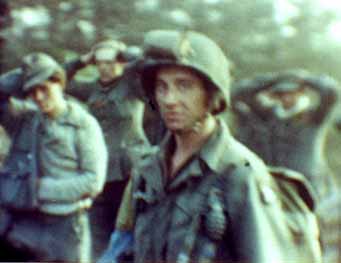 Above is a single frame from a 16mm color movie shot by Captain Frank Lillyman on 18 September, 1944, as members of RHQ and Service Companies of the 502 marched an estimated 12-1500 German POWs east toward Zon from the Best battleground. Note that all the visible prisoners are wounded. Len Swartz and Rusty Quirici were among the guards. Len told me that P-47 fighters made a couple of strafing passes at the marching prisoners, causing some deaths and much panic and near catastrophe, as the cooperative and organized group of prisoners threatened to scatter. But order was maintained. Dick Ladd of S-2 recalled in his account of this battle that two of the British tanks which entered the woods earlier, were equipped with flamethrowers.
Above is a single frame from a 16mm color movie shot by Captain Frank Lillyman on 18 September, 1944, as members of RHQ and Service Companies of the 502 marched an estimated 12-1500 German POWs east toward Zon from the Best battleground. Note that all the visible prisoners are wounded. Len Swartz and Rusty Quirici were among the guards. Len told me that P-47 fighters made a couple of strafing passes at the marching prisoners, causing some deaths and much panic and near catastrophe, as the cooperative and organized group of prisoners threatened to scatter. But order was maintained. Dick Ladd of S-2 recalled in his account of this battle that two of the British tanks which entered the woods earlier, were equipped with flamethrowers. 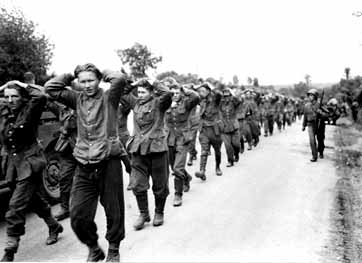 Above is another view of a small percentage of the prisoners taken on 18 September, 1944 near Best, Holland. Thanks to Joe Pangerl, Len Swartz, Oreste Quirici, and Dick Ladd for contributing to this story.
Above is another view of a small percentage of the prisoners taken on 18 September, 1944 near Best, Holland. Thanks to Joe Pangerl, Len Swartz, Oreste Quirici, and Dick Ladd for contributing to this story.
History vs Hollywood- Captain Legs Johnson
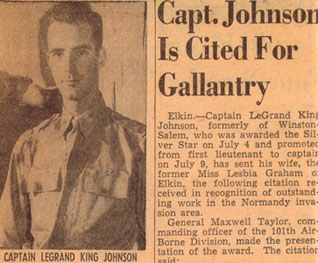 Captain LeGrand King "Legs" Johnson was company commander of F/502. He won the Silver Star Medal on 13 June, 1944 in Normandy, for leading a M-4 Tank of the 66th Armored Regiment to rescue part of his company, which had been surrounded by elements of the 17th SS division.
Captain LeGrand King "Legs" Johnson was company commander of F/502. He won the Silver Star Medal on 13 June, 1944 in Normandy, for leading a M-4 Tank of the 66th Armored Regiment to rescue part of his company, which had been surrounded by elements of the 17th SS division.
On 18 September, 1944, Johnson's battalion (2/502) was attacking west toward Best, Holland in concert with third battalion. German fire came in murderous volume and Legs
called the Dog Co. commander, Francis 'Bud'Rainey on the radio.
"Bud, bring your company up on line with us!" Legs yelled.
"Fuck YOU!", came the reply.
Soon after, a rifle bullet wounded Legs Johnson in the right shoulder. Medics made him lie down and set up an IV with plasma flowing into him. Medical jeeps bearing stretchers were evacuating wounded two at a time, to a field hospital in Son.
Since many of the wounded were hit more seriously than himself, Legs kept delaying his own evacuation, telling the medics to convey the others first. Even when Legs was finally loaded, he was still telling them to delay and take others. Against his objections, he was placed across the hood of the jeep on a stretcher and then the jeep scratched-off, headed for Son.
At that time, a German MG42 machinegun fired at the jeep from over 500 yards distance. One round entered Legs' helmet and tore into his head. He lost consciousness and would not wake -up until weeks later.
At the hospital in Son, Legs was briefly examined and since he was unconscious and his brains were exposed, he was relegated to the 'dead pile' of troopers who were wounded so seriously that they had no chance to survive.
Later that afternoon, Sgt Charles DOHUN (Hollywood changed his first name to EDDIE), who was Legs' runner wandered over to the hospital for a specific purpose. He knew that the captain had a substantial amount of cash in his billfold and he didn't want a stranger from another unit to get it.
Dohun spotted Captain Johnson in the dead pile and examined him-when he discovered that Legs was still breathing, he carried him into an operating room and ordered the surgeon to save him. When the doctor refused, Dohun pointed a souvenir Luger at him and threatened to shoot him (he did not use a .45 as shown in 'A Bridge Too Far', but a .45 looks more impressive).
The operation was successful. Legs regained consciousness six weeks later in a hospital, "deaf, dumb, blind, and with a steel plate in my head." As of this writing (October, 2005), Legs is still alive in Florida. Charles Dohun survived WW2 and lived in N.C. until his death about 15 years ago.
Regarding the Hollywood DepictionWhen I interviewed Legs Johnson in the late 1990's, he commented on how he and Sgt Dohun were portrayed in 'A Bridge Too Far', the 1977 Hollywood version of Cornelius Ryan's book about Operation Market Garden.
Legs said :"In the movie, I was a little, scared guy, and Dohun was a great big guy. Hell, in real life I would've made TWO of Dohun."
Cornelius Ryan described in his book, how Sgt Dohun was placed under arrest for threatening to shoot the surgeon. I have not learned the identity of that doctor, but he did NOT pardon the sgt, as shown in the film. Sgt Dohun was taken before LTC Steve Chappuis, the 2/502 C.O. and Silent Steve placed him under arrest for one minute. As Dohun stood at attention before his desk, the LTC looked at his watch for sixty seconds, then told Dohun he could go.
Captain Hugh 'Duke' Roberts, the second battalion S-1 of the 502 PIR, was among the few indiividuals who knew the story of how Dohun had ordered the doctor to perform the operation, at gunpoint. Duke wrote a letter to Mrs Johnson,(Legs' wife), explaining how Sgt Dohun had been responsible for saving his life. When Cornelius Ryan was researching 'A Bridge Too Far', Mrs Johnson sent that letter to Ryan, which is HOW the author became aware of the story. Chappuis and Roberts were close friends, and Chappuis brought Duke up to become the regimental S-1 after he (Chappuis) had succeeded Michaelis as regimental commander.
Although many European historians believe that American troops never advanced in their attack beyond the Best/Eindhoven highway (which is now a super expressway), Emmert Parmley of F/502 says that the 2nd platoon of his company did manage to attack one half mile beyond that highway after getting British tank support on the 19th of September. The attackers had been told to guide on the church steeple to the northwest. Although they never got near that church, the 2nd platoon dug-in and spent the night of 19/20 September, 1944, 1/2 mile west of the highway, inside the town of Best, before withdrawing to their former positions above the Wilhelmina Canal, east of the highway.
As a point of trivia interest, he also says that Legs Johnson was shot not far east of where the McDonald's restaurant now stands, on the west side of the expressway.
When the film 'A Bridge Too Far'was first released, I heard many 101 vets discussing it. They did not appreciate the way the captain based on Legs was depicted, "having to get his courage out of a bottle."
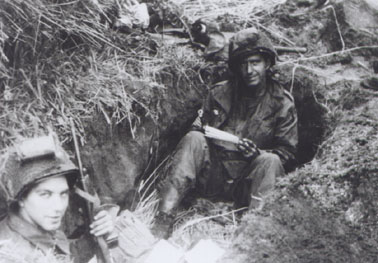 How seldom we see actual photos of combat troopers in foxholes, on the front lines.
How seldom we see actual photos of combat troopers in foxholes, on the front lines.
This excellent shot was taken in the area described above (between Best/Son, Holland), circa 18-19 September, 1944. The cameraman was Len Swartz, the regimental mail clerk of the 502 PIR. Unfortunately, the faces have not been identitifed, but they were probably members of RHQ or Service Co. of the Deuce.
This foxhole was dug next to a haypile and the occupants vacated it just in time the next day.
A C-47 bearing re-supply was shot down and crashed on this very spot soon after the troopers left it.
Cheating Death
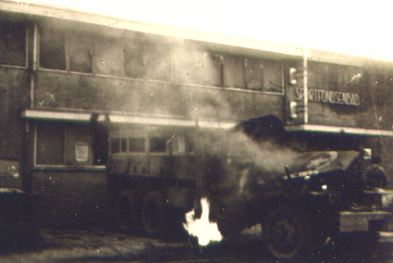 This photo was taken in November, 1944, in Nijmegen, Holland. The truck is afire, as a result of taking a direct hit from a German artillery shell.
This photo was taken in November, 1944, in Nijmegen, Holland. The truck is afire, as a result of taking a direct hit from a German artillery shell.
Captain Joe Pangerl and his driver, Sgt Fred Patheiger, had driven to this building from the Betuwe (island), to take a shower. To avoid having their jeep stolen, it was necesary for one guy to stay with it at all times. So Pangerl showered first, then switched places with Patheiger. As Joe was waiting for Fred to come out, this truck loaded with 16 members of the 506th PIR, pulled-up, driven by a 506th Service Co. driver. The troopers piled out and went-in to take their showers.
Captain Pangerl got out of his jeep and sat in the pasenger seat in the cab of the truck, making conversation with the driver. Soon after, another jeep pulled up and parked next to Pangerl's jeep, a bit farther away from the truck. Joe recognized the officer in that jeep, so he exited the truck and went and sat in the jeep, to talk to the new arrival.
Soon thereafter, a random German shell, fired from miles away, made a direct hit on the cab of the truck which Pangerl had just gotten out of. The shell hit exactly whre he had been sitting and killed the driver. Joe's jeep, which was parked closer to the truck than the one he was sitting-in, also received multiple shell fragments.
It seems that all the 101st paratroopers who survived WW2 combat had similar escapes from death. Another example that happened to Joe Pangerl, can be found on page three of Souvenirs, ('Significant Scrap Metal').
Too Close for Comfort
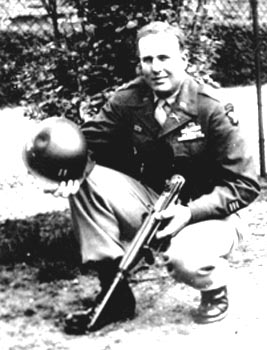 While fighting north of Bastogne, Belgium in January, 1945, a German bullet dinged the steel pot of Captain Wallace Swanson, Commnding Officer of Company 'A', 502 PIR. He escaped with nothing more serious than a headache. The photo above was taken in the spring of 1945, as Swanie posed with his helmet while wearing a Class 'A' uniform and holding his M1-A1 carbine. photo courtesy Wally Swanson
While fighting north of Bastogne, Belgium in January, 1945, a German bullet dinged the steel pot of Captain Wallace Swanson, Commnding Officer of Company 'A', 502 PIR. He escaped with nothing more serious than a headache. The photo above was taken in the spring of 1945, as Swanie posed with his helmet while wearing a Class 'A' uniform and holding his M1-A1 carbine. photo courtesy Wally Swanson
Misadventures of a Dogtag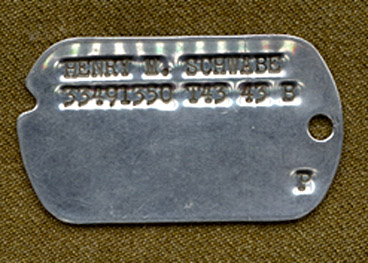 Pvt Henry Schwabe was a paratrooper in HQ/2 501 PIR. Henry's parents were from Germany, but Henry had been raised in Pottstown, PA. He joined the LMG platoon shortly before the D-Day invasion, but according to his pal, Charlie Eckman, Schwabe was considered a security risk because of his ancestry and not allowed to jump into Normandy.
Pvt Henry Schwabe was a paratrooper in HQ/2 501 PIR. Henry's parents were from Germany, but Henry had been raised in Pottstown, PA. He joined the LMG platoon shortly before the D-Day invasion, but according to his pal, Charlie Eckman, Schwabe was considered a security risk because of his ancestry and not allowed to jump into Normandy.
Schwabe did jump into Holland and participated in the defense of Bastogne. On 3 January, 1945, Schwabe and Eckman ran across hundreds of yards of snow-covered open ground, to search for survivors in a gravel pit below the Bois Jacques Woods. Searching through a pile of about 14 dead American bodies with glazed eyes, the duo located a buddy, Harry Coffey, who was unwounded but mentally delerious, as he had been shell shocked and buried under the bodies for several hours. While dragging
Coffey back to the woods, Schwabe's dogtags evidently dangled below him, snagged on something and the lower tag tore off, unnoticed as it dropped into the snow.
A year or two later, a Belgian civilian spotted the dogtag as he was strolling in the fields above Bastogne in nicer weather, and picked it up. He kept it until the spring of 1999, when he gave it to Belgian researcher Pierre Godeau.
In September of 1999
I toured the Bois Jacques area with Bruce Mabey, and told him how Schwabe and Eckman had rescued Harry Coffey there on 3 January, 1945. I added that I had written about this in my 2d book, and that Schwabe had been killed a month later in Alsace, while returning from a night patrol.
That evening while at a hotel in Bastogne, I phoned Pierre, who lives outside Bastogne and invited him to visit, asking him to bring along any recent acquisitions in his collection of Bastogne artifacts. Pierre showed up at the hotel with a variety of battle relics from the area, including two single dogtags he'd acquired from local citizens during his 1999 spring Expo.
One of those dogtags belonged to a 327th man named Schimmelpfennig, who entered the Army from the midwest. The other tag he handed me caused my heart to skip a beat-it was the tag pictured above-of Henry Schwabe. I recently worked out a trade with Pierre and acquired the tag for my collection in January of 2001.
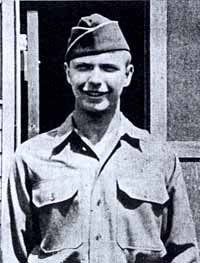 In May, 2001, I acquired this photo, the only one I've ever seen, of Henry Schwabe. This comes courtesy of Don Bartmann who also lived in Pottstown, PA before joining the US Army. Don was in F Company of the 501 and ran into Henry in a chowline at Camp Mourmelon before Bastogne. It happens they had both dated the same girl before joining-up. Don recalls that Henry was a devout Methodist. He was born 9 December, 1923, and KIA on 22 February, 1945. Don writes: "Henry deserved more than that-he was a wonderful person, a fine soldier, and as devoted to the American cause as anybody I met in my wartime experience. He gave it all."
In May, 2001, I acquired this photo, the only one I've ever seen, of Henry Schwabe. This comes courtesy of Don Bartmann who also lived in Pottstown, PA before joining the US Army. Don was in F Company of the 501 and ran into Henry in a chowline at Camp Mourmelon before Bastogne. It happens they had both dated the same girl before joining-up. Don recalls that Henry was a devout Methodist. He was born 9 December, 1923, and KIA on 22 February, 1945. Don writes: "Henry deserved more than that-he was a wonderful person, a fine soldier, and as devoted to the American cause as anybody I met in my wartime experience. He gave it all."
MARK BANDO'S WEBSITE
PHOTO GALLERY
This is a new 'permanent' feature. I will post here some excellent WW2 vintage photos, most of which have not been published before.
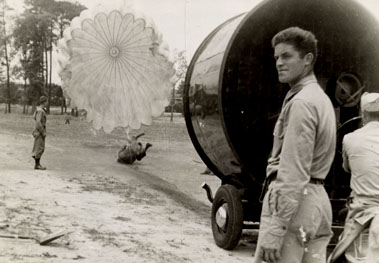 At Ft Benning in 1942,a typical sadistic instructor at TPS watches the wind machine blow a student paratrooper along the ground. This training taught students how to recover when being dragged in high winds, how to stand up, collapse the canopy and regain control. Musura photo c/o Senyszyn
At Ft Benning in 1942,a typical sadistic instructor at TPS watches the wind machine blow a student paratrooper along the ground. This training taught students how to recover when being dragged in high winds, how to stand up, collapse the canopy and regain control. Musura photo c/o Senyszyn
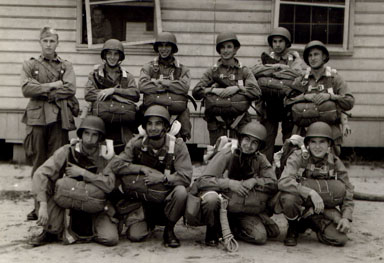 Members of RHQ/502 PIR, mostly from the S-2 section, posed before a practice jump at Ft Bragg in 1943. photo c/o R. Ladd
Members of RHQ/502 PIR, mostly from the S-2 section, posed before a practice jump at Ft Bragg in 1943. photo c/o R. Ladd
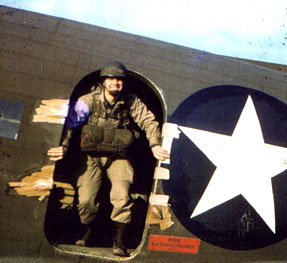 Lt. Donald J. Hettrick of D/377th PFAB posed in the door of a C-47 before taking off for a practice jump at Pope Field, NC in early 1943. From Kodachrome slide c/o D.J. Hettrick
Lt. Donald J. Hettrick of D/377th PFAB posed in the door of a C-47 before taking off for a practice jump at Pope Field, NC in early 1943. From Kodachrome slide c/o D.J. Hettrick
Now They are World Famous
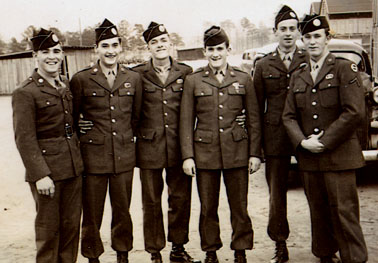 This photo was made at the beginning of 1943, just as Easy Co. 506th members were graduating from jump school. They still wear the GHQ Reserve SSI. Left to right: Johnny Martin, Angelo Dukelis, Albert Blithe, Bill Guarnere, unk., and Burton Pat Christenson-photo courtesy of the Christenson family
This photo was made at the beginning of 1943, just as Easy Co. 506th members were graduating from jump school. They still wear the GHQ Reserve SSI. Left to right: Johnny Martin, Angelo Dukelis, Albert Blithe, Bill Guarnere, unk., and Burton Pat Christenson-photo courtesy of the Christenson family
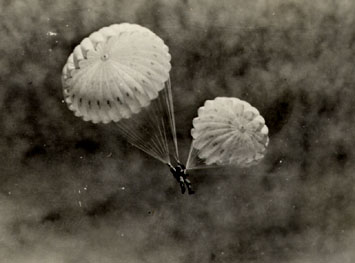 Troopers were trained never to pull the ripcord of their reserve chest pack unless there was a true malfunction of the main chute. This trooper obviously panicked and did it anyway. The smaller reserve canopy could go under the main one, stealing air and guaranteeing a malfunction, but this descent looks ok.
The photo is instructive because it illustrates the difference in size of the 2 canopies 28' and 24'.
Troopers were trained never to pull the ripcord of their reserve chest pack unless there was a true malfunction of the main chute. This trooper obviously panicked and did it anyway. The smaller reserve canopy could go under the main one, stealing air and guaranteeing a malfunction, but this descent looks ok.
The photo is instructive because it illustrates the difference in size of the 2 canopies 28' and 24'.
A certain battalion commander had a bad habit of pulling his reserve on every single practice jump. The Riggers got tired of always having to repack his reserve, so one day, they reportedly filled the reserve pack with sawdust. I'm not sure what happened, but I heard this cured the field grade officer of his bad habit. SC photo c/o Senyszyn
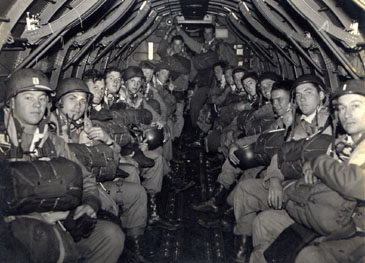 Night Practice Jump, Thursday, 11 May, 1944, 2230 hrs in England. This stick is from Third Bn. Headquarters Co. of the Deuce. Captain Edward 'Poop' Barrett is seated at left, while Lt. Corey Shepard is seated in the right foreground. Willis 'Bill' Cady is 7th man at the end of the left row (see Bad Bastards page for stories about Bill Cady). Joe Lofthouse a 3rd Bn HQ Co. radio operator has also been spotted in the photo.
SC photo c/o Joe Pangerl IPW Team #1, 502 PIR
Night Practice Jump, Thursday, 11 May, 1944, 2230 hrs in England. This stick is from Third Bn. Headquarters Co. of the Deuce. Captain Edward 'Poop' Barrett is seated at left, while Lt. Corey Shepard is seated in the right foreground. Willis 'Bill' Cady is 7th man at the end of the left row (see Bad Bastards page for stories about Bill Cady). Joe Lofthouse a 3rd Bn HQ Co. radio operator has also been spotted in the photo.
SC photo c/o Joe Pangerl IPW Team #1, 502 PIR
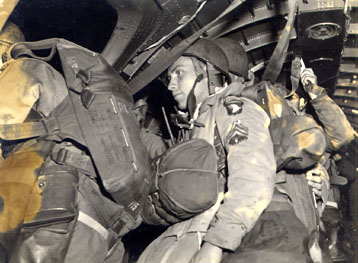 11 May 1944 again, the same stick of 3/502, standing in the door. Note the regular infantry uniforms instead of jumpsuits.
T-5 Del Winslow the central figure in this photo is also visible in the previous photo, seated 2nd from left, next to Poop Barrett.SC photo c/o JP
11 May 1944 again, the same stick of 3/502, standing in the door. Note the regular infantry uniforms instead of jumpsuits.
T-5 Del Winslow the central figure in this photo is also visible in the previous photo, seated 2nd from left, next to Poop Barrett.SC photo c/o JP
Normandy in Color
 This is one of the amazing color Kodachrome slides taken by Captain (doctor) George Lage in Normandy. Lage was 2nd battalion surgeon of the 502 PIR, and he posed here with some of his medics. Thanks to Ernie Labadie, we have names for all the faces, but the location has not been determined. I thought it was taken in St Come du Mont, but Ian Gardner, with help from long-time residents in St Come, have ruled that town out.
This is one of the amazing color Kodachrome slides taken by Captain (doctor) George Lage in Normandy. Lage was 2nd battalion surgeon of the 502 PIR, and he posed here with some of his medics. Thanks to Ernie Labadie, we have names for all the faces, but the location has not been determined. I thought it was taken in St Come du Mont, but Ian Gardner, with help from long-time residents in St Come, have ruled that town out.
Pictured standing, from l. to r.:Captain George Lage, S/Sgt John Durka (KIA soon after the photo was made), Leroy Reitz, James Milne, and unk. GRS man. below: Fred 'Oakie' O'Connell,
James Learnard and another unk. GRS (Graves Registration Service) trooper. The GRS men were probably members of Service Co. 502. At the time this was taken, another 2/502 medic, Robert Haseltine, had already been killed in action.
The remarkable detail in this photo allows us to see the camo green chute canopy scarves, rigger-modified clothing, various applications of helmet scrim etc. Also note the German belt and buckle and Mauser rifle acquired by Sgt Durka.
More of Doc Lage's wonderful photos can be found in my 4th book, '101st Airborne-The Screaming Eagles at Normandy'. All Doc Lage photos appear courtesy of Allan and Brenda Mitchell, the late doctor's daughter and son-in-law.
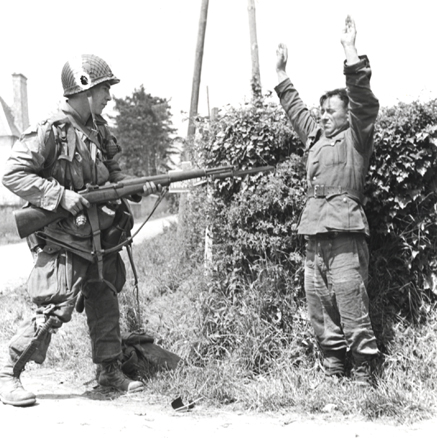 This is one of 2 famous photos taken by S.C. personnel at the road junction directly south of Turqueville,
France, on 7 June, 1944. Wilbur Shanklin posed, holding his M-1, with fixed bayonet on a rather terrified
German officer (identifiable as such by his belt). Shanklin belonged to RHQ/506th PIR and the German was
quite likely a member of the 795th Ost Battalion. photo c/o F. Wozniak collection
This is one of 2 famous photos taken by S.C. personnel at the road junction directly south of Turqueville,
France, on 7 June, 1944. Wilbur Shanklin posed, holding his M-1, with fixed bayonet on a rather terrified
German officer (identifiable as such by his belt). Shanklin belonged to RHQ/506th PIR and the German was
quite likely a member of the 795th Ost Battalion. photo c/o F. Wozniak collection
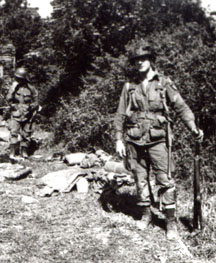 Cpl George Spear was photographed during a rest break in Normandy by buddy Eddie Sapinski. Spear was killed in action early in the Holland campaign near Best.
photo c/o Sapinski
Cpl George Spear was photographed during a rest break in Normandy by buddy Eddie Sapinski. Spear was killed in action early in the Holland campaign near Best.
photo c/o Sapinski
Preparing for Market Garden
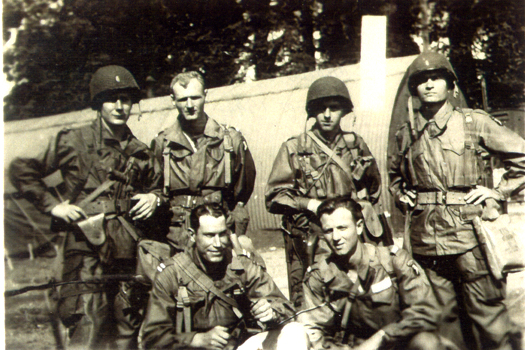 Joe Pangerl's camera recorded this group at Chilton Foliat, England, shortly before the Holland Invasion in September, 1944.
Joe Pangerl's camera recorded this group at Chilton Foliat, England, shortly before the Holland Invasion in September, 1944.
Standing l. to r.: Lt. Richard J. Daly (KIA), Lt. Larry Hughes, Lt. Ed Cowen, Lt. Bernard Usry, below: Captain Ike Phillips, Lt. Joe Pangerl. c/o Joe Pangerl
D-day in Holland
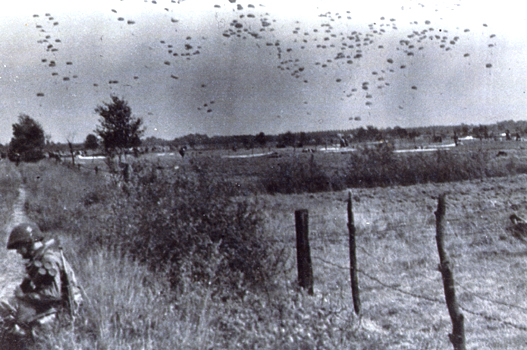 Al Krochka, assigned as one of the divisional photographers for Market Garden, took this amazing photo on 17 September, 1944. The bazookaman at left wears a 2/501st helmet stencil, and presumably, the serial floating to earth in the distance is 3/501 arriving.
Al Krochka, assigned as one of the divisional photographers for Market Garden, took this amazing photo on 17 September, 1944. The bazookaman at left wears a 2/501st helmet stencil, and presumably, the serial floating to earth in the distance is 3/501 arriving.
This is presumably DZ 'A', near Eerde, Holland. Another Krochka photo, taken from the same place a minute earlier, appears in Karel Margry's excellent 1st volume on Market Garden Then & Now (see Books pages). For whatever reason, the photo above was not included. You will find Margry's information to be very authoritative and his books tell you where the serials departed from, which TCGs carried which PIRs to which DZ's, and also the sequence in which they landed.
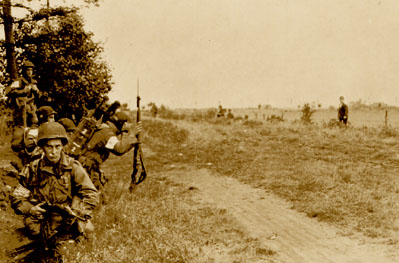 This one is at the Son DZ on 17 September, 1944. Joe Crawford of RHQ/506th is in left foreground-this one has been published before. SC photo c/o JP
This one is at the Son DZ on 17 September, 1944. Joe Crawford of RHQ/506th is in left foreground-this one has been published before. SC photo c/o JP
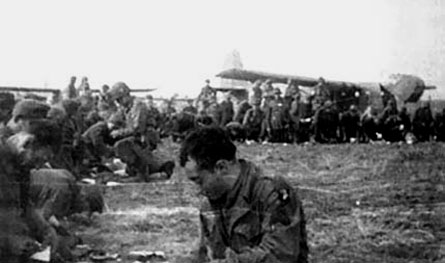 On 18 September, 1944, some German prisoners were taken on the edge of LZ 'W' near Son, Holland. In this photo, some HQ/502 personnel are writing down names of the prisoners and a couple of recently-landed CG-4A gliders are visible in the background. Trooper in the foreground is S-2 man August 'Gus' Mangoni, who had jumped as a Pathfinder in Normandy. Lt.Joe Pangerl snapped this dramatic photo while on the move and very busy. Charles Day did some work on this pic in late 2003, to clean up the imperfections and enhance it.
On 18 September, 1944, some German prisoners were taken on the edge of LZ 'W' near Son, Holland. In this photo, some HQ/502 personnel are writing down names of the prisoners and a couple of recently-landed CG-4A gliders are visible in the background. Trooper in the foreground is S-2 man August 'Gus' Mangoni, who had jumped as a Pathfinder in Normandy. Lt.Joe Pangerl snapped this dramatic photo while on the move and very busy. Charles Day did some work on this pic in late 2003, to clean up the imperfections and enhance it.
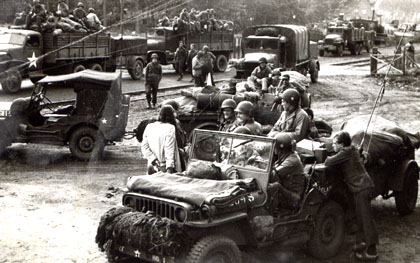 A scene along Hell's Highway in September, 1944. The occupants of the jeep are members of 101st Divarty. photo courtesy of Nadine W.
A scene along Hell's Highway in September, 1944. The occupants of the jeep are members of 101st Divarty. photo courtesy of Nadine W.
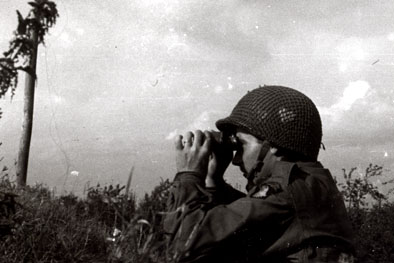 This pic shows Lt.Delmar Denson Idol of A/502 on a combat patrol near Dodewaard, Holland on the Island in October, 1944. Capt. Joe Pangerl photographed Idol as he scanned no man's land for signs of dug-in German positions. photo c/o J.P.
This pic shows Lt.Delmar Denson Idol of A/502 on a combat patrol near Dodewaard, Holland on the Island in October, 1944. Capt. Joe Pangerl photographed Idol as he scanned no man's land for signs of dug-in German positions. photo c/o J.P.
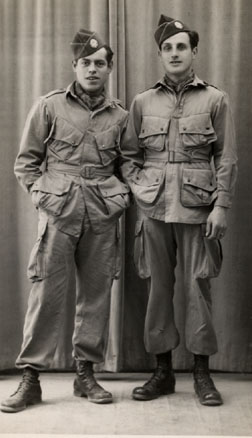 Epifanio Morici(rt.)and a Hispanic trooper identified only as 'Mex from Tex' in a late 1944 studio portrait somewhere in the ETO.
Morici was in Service Co. Parachute Maintenance Section, 501 PIR.
MARK BANDO'S WEBSITE
Epifanio Morici(rt.)and a Hispanic trooper identified only as 'Mex from Tex' in a late 1944 studio portrait somewhere in the ETO.
Morici was in Service Co. Parachute Maintenance Section, 501 PIR.
MARK BANDO'S WEBSITE
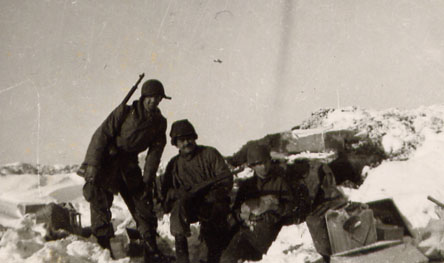 Arctic battleground -several troopers from Sv Co. 506th PIR existing in the snow near Savy, Belgium, December, 1944. c/o Dean Baxter
Arctic battleground -several troopers from Sv Co. 506th PIR existing in the snow near Savy, Belgium, December, 1944. c/o Dean Baxter
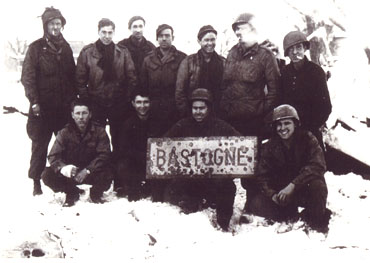 A slightly different version of this photo appears in my 'Vanguard' book. Members of RHQ/501 PIR posed with the bulletholed town sign for photographer Joe 'Gopher'Sloan. This classic sign was taken to Brussels after the war, where M/Sgt Peter Frank left it with his family. Recently, Peter Frank passed away in Austria. Sadly, the sign was presumably thrown in the trash some time after WW2. photo c/o Rollie Wilbur
A slightly different version of this photo appears in my 'Vanguard' book. Members of RHQ/501 PIR posed with the bulletholed town sign for photographer Joe 'Gopher'Sloan. This classic sign was taken to Brussels after the war, where M/Sgt Peter Frank left it with his family. Recently, Peter Frank passed away in Austria. Sadly, the sign was presumably thrown in the trash some time after WW2. photo c/o Rollie Wilbur
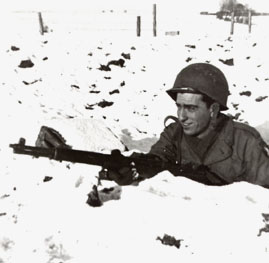 A member of 101st Division Signal Company in a foxhole with his trusty M-1 at Bastogne. photo c/o F. Sheehan.
A member of 101st Division Signal Company in a foxhole with his trusty M-1 at Bastogne. photo c/o F. Sheehan.
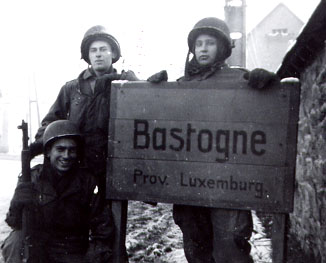 December, 1944, three members of Division Signal Company, 101st Airborne Division pose with another of the town signs, on the road coming-in from the northwest perimeter. This was taken right across the street from the Belgian Army barracks', where General McAuliffe established his divisional C.P. and where he made the classic 'Nuts' reply to the German demand for surrender. The stone wall at right is the edge of the town cemetery, and a comparison of this shot can still be made in the new milennium. The new sign is situated about 100 yards north of the position shown in this photo.
December, 1944, three members of Division Signal Company, 101st Airborne Division pose with another of the town signs, on the road coming-in from the northwest perimeter. This was taken right across the street from the Belgian Army barracks', where General McAuliffe established his divisional C.P. and where he made the classic 'Nuts' reply to the German demand for surrender. The stone wall at right is the edge of the town cemetery, and a comparison of this shot can still be made in the new milennium. The new sign is situated about 100 yards north of the position shown in this photo.
photo courtesy of F. Sheehan.
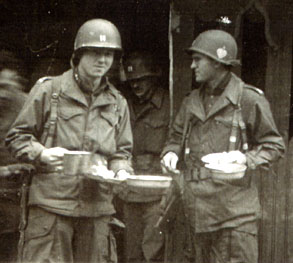 Feb., 1945 at Eckendorf, in Alsace-Lorraine, France, Captains Joe Pangerl and Fred Hancock of the 502 PIR, preparing to indulge in evening chow. c/o Pangerl
Feb., 1945 at Eckendorf, in Alsace-Lorraine, France, Captains Joe Pangerl and Fred Hancock of the 502 PIR, preparing to indulge in evening chow. c/o Pangerl
MARK BANDO'S WEBSITE
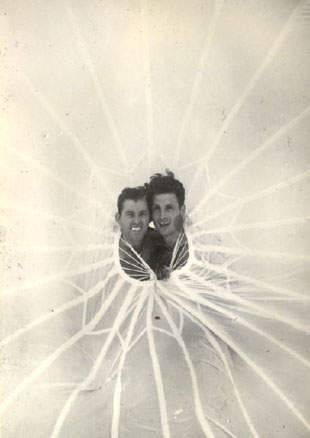 Epifanio Morici(rt) and an unknown companion from Service Co. Riggers Section
(Parachute Maintenance) 501 PIR in 1945. M/Sgt Harvey might be the unidentified trooper.
Epifanio Morici(rt) and an unknown companion from Service Co. Riggers Section
(Parachute Maintenance) 501 PIR in 1945. M/Sgt Harvey might be the unidentified trooper.
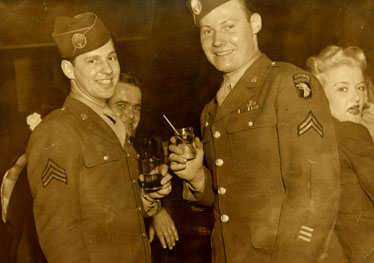 Ralph Smeal and Larry Loyen of B/506th having a ball in Paris after Alsace in spring, 1945. You'll note that although Larry wears the ribbon for a Purple Heart, he doesn't bother to wear his Combat Infantryman's Badge. photo courtesy Herb Clark.
Ralph Smeal and Larry Loyen of B/506th having a ball in Paris after Alsace in spring, 1945. You'll note that although Larry wears the ribbon for a Purple Heart, he doesn't bother to wear his Combat Infantryman's Badge. photo courtesy Herb Clark.
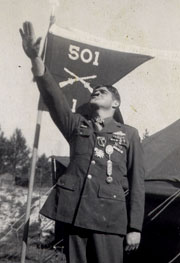 At Mourmelon in spring, 1944,a member of HQ Co. 1st Bn, 501 PIR gives his impression of Der Fuhrer. c/o Paul Bebout
At Mourmelon in spring, 1944,a member of HQ Co. 1st Bn, 501 PIR gives his impression of Der Fuhrer. c/o Paul Bebout
Below the Adlerhorst
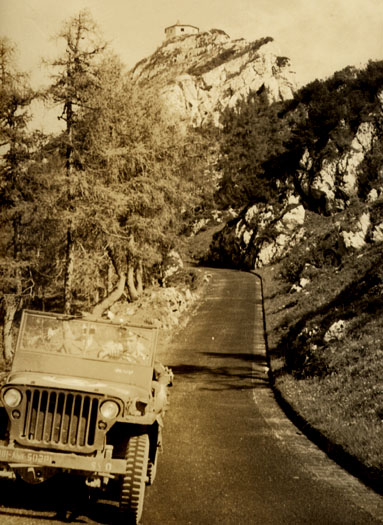 The infamous Eagle's Nest on Kehlstein mountain, overlooking Berchtesgaden, Germany was a special conference center built in 1938, as a birthday present for Hitler. In this fabulous 1945 photo by Captain Joe Pangerl of the 502 PIR, you can see the building in the upper distance, at the very summit of the mountain. This building is now a popular tourist attraction, known as the Kehlstein Tea House. In a verbal swipe at Hitler, many 101st troopers referred to this place as 'The Crow's Nest'.
The infamous Eagle's Nest on Kehlstein mountain, overlooking Berchtesgaden, Germany was a special conference center built in 1938, as a birthday present for Hitler. In this fabulous 1945 photo by Captain Joe Pangerl of the 502 PIR, you can see the building in the upper distance, at the very summit of the mountain. This building is now a popular tourist attraction, known as the Kehlstein Tea House. In a verbal swipe at Hitler, many 101st troopers referred to this place as 'The Crow's Nest'.
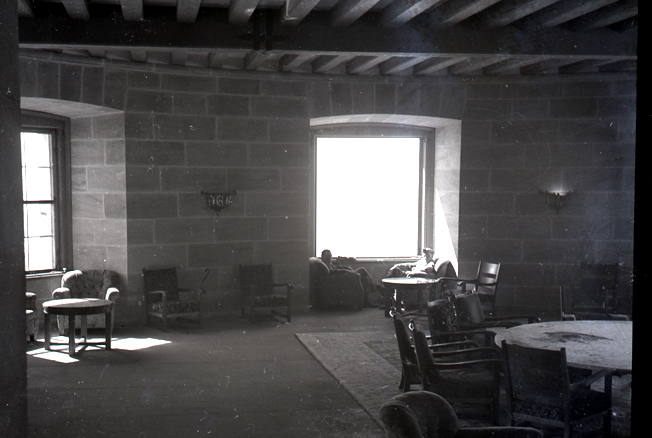 Captain Joe Pangerl (502) of IPW Team #1, took this photo showing the interior of the Eagle's Nest, with the large,
square windows (which are a fraction of the size of the panoramic window at the Berghof), in May, 1945.
Captain Joe Pangerl (502) of IPW Team #1, took this photo showing the interior of the Eagle's Nest, with the large,
square windows (which are a fraction of the size of the panoramic window at the Berghof), in May, 1945.
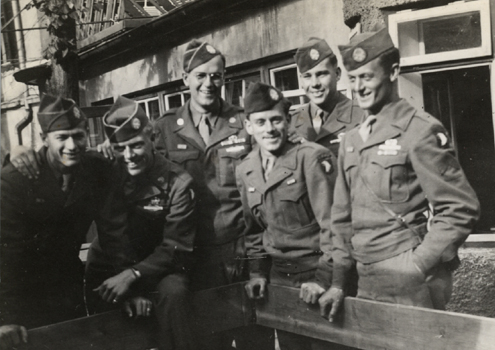 Taken July, 1945 at the Red Cross center in Zell am Zee, Austria, this is one of my single favorite 101st photos from WW2. It has paratroopers from all 3 PIRs of the division in a single shot.
Taken July, 1945 at the Red Cross center in Zell am Zee, Austria, this is one of my single favorite 101st photos from WW2. It has paratroopers from all 3 PIRs of the division in a single shot.
Standing l. to r.: Harold Curry, Eddie Schultz and Ted Goldman (all A/502),Sprogue(?) (first name unk), H/506th, Bill Canfield and Joe 'Gopher' Sloan, H&H S-2, 501 PIR.
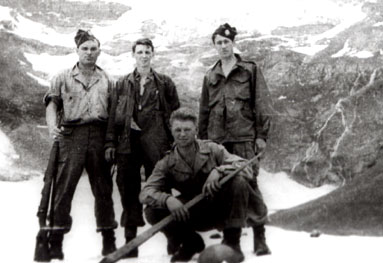 Mountain Climbers-G/506th troopers, in the Austrian alps, summer 1945. Jim Pee Wee Martin is standing in the center. c/o J. Martin
Mountain Climbers-G/506th troopers, in the Austrian alps, summer 1945. Jim Pee Wee Martin is standing in the center. c/o J. Martin
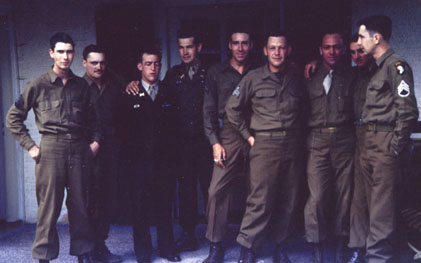 A group of officers and NCOs of the 907th GFAB, photographed at Bad Reichenhall, Germany in mid 1945. from Kodachrome slide c/o D.J. Hettrick
A group of officers and NCOs of the 907th GFAB, photographed at Bad Reichenhall, Germany in mid 1945. from Kodachrome slide c/o D.J. Hettrick
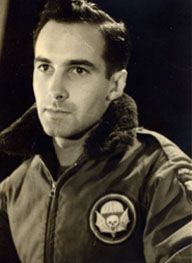 Jack Ott jumped as an S-2 liason to the 502 Pathfinders, in Captain Lillyman's stick on D-day. He served throughout WW2 in the S-2 section of RHQ/502 PIR. This studio portrait was made in Paris in 1945, and shows Jack wearing an Air Corps jacket with the 502 regimental pocket patch in place. courtesy Dick Ladd.
Jack Ott jumped as an S-2 liason to the 502 Pathfinders, in Captain Lillyman's stick on D-day. He served throughout WW2 in the S-2 section of RHQ/502 PIR. This studio portrait was made in Paris in 1945, and shows Jack wearing an Air Corps jacket with the 502 regimental pocket patch in place. courtesy Dick Ladd.












































